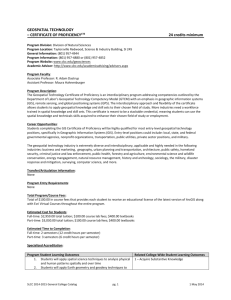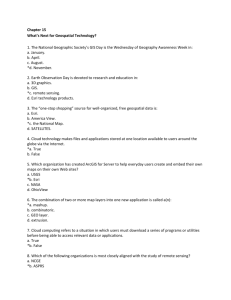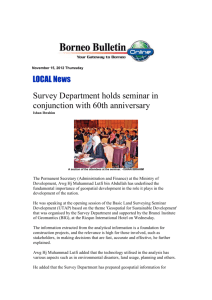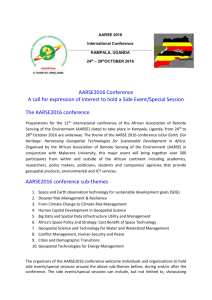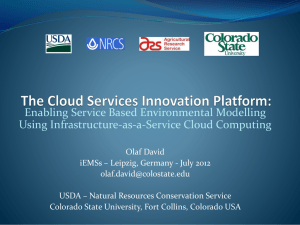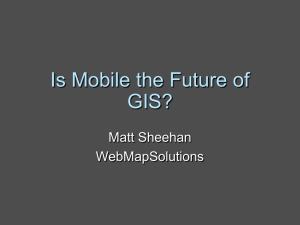Salt Lake Community College Program Curriculum Outline (PCO
advertisement
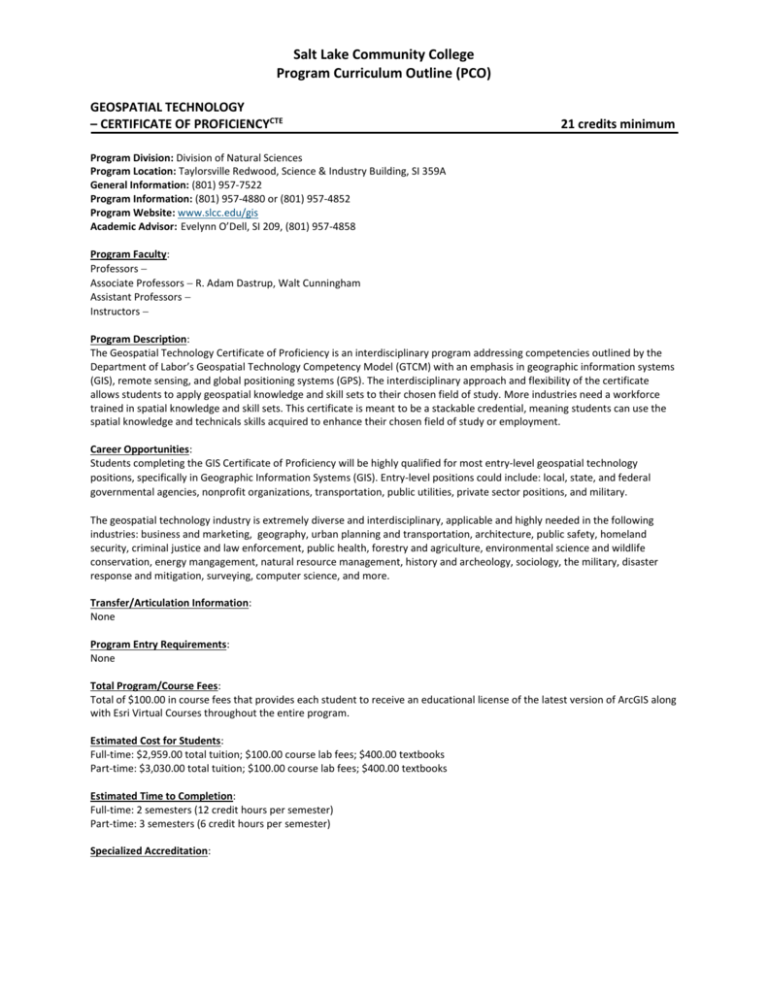
Salt Lake Community College Program Curriculum Outline (PCO) GEOSPATIAL TECHNOLOGY – CERTIFICATE OF PROFICIENCYCTE 21 credits minimum Program Division: Division of Natural Sciences Program Location: Taylorsville Redwood, Science & Industry Building, SI 359A General Information: (801) 957-7522 Program Information: (801) 957-4880 or (801) 957-4852 Program Website: www.slcc.edu/gis Academic Advisor: Evelynn O’Dell, SI 209, (801) 957-4858 Program Faculty: Professors Associate Professors R. Adam Dastrup, Walt Cunningham Assistant Professors Instructors Program Description: The Geospatial Technology Certificate of Proficiency is an interdisciplinary program addressing competencies outlined by the Department of Labor’s Geospatial Technology Competency Model (GTCM) with an emphasis in geographic information systems (GIS), remote sensing, and global positioning systems (GPS). The interdisciplinary approach and flexibility of the certificate allows students to apply geospatial knowledge and skill sets to their chosen field of study. More industries need a workforce trained in spatial knowledge and skill sets. This certificate is meant to be a stackable credential, meaning students can use the spatial knowledge and technicals skills acquired to enhance their chosen field of study or employment. Career Opportunities: Students completing the GIS Certificate of Proficiency will be highly qualified for most entry-level geospatial technology positions, specifically in Geographic Information Systems (GIS). Entry-level positions could include: local, state, and federal governmental agencies, nonprofit organizations, transportation, public utilities, private sector positions, and military. The geospatial technology industry is extremely diverse and interdisciplinary, applicable and highly needed in the following industries: business and marketing, geography, urban planning and transportation, architecture, public safety, homeland security, criminal justice and law enforcement, public health, forestry and agriculture, environmental science and wildlife conservation, energy mangagement, natural resource management, history and archeology, sociology, the military, disaster response and mitigation, surveying, computer science, and more. Transfer/Articulation Information: None Program Entry Requirements: None Total Program/Course Fees: Total of $100.00 in course fees that provides each student to receive an educational license of the latest version of ArcGIS along with Esri Virtual Courses throughout the entire program. Estimated Cost for Students: Full-time: $2,959.00 total tuition; $100.00 course lab fees; $400.00 textbooks Part-time: $3,030.00 total tuition; $100.00 course lab fees; $400.00 textbooks Estimated Time to Completion: Full-time: 2 semesters (12 credit hours per semester) Part-time: 3 semesters (6 credit hours per semester) Specialized Accreditation: Salt Lake Community College Program Curriculum Outline (PCO) Program Student Learning Outcomes 1. Students will apply spatial science techniques to analyze physical and human patterns spatially and over time 2. Students will apply Earth geometry and geodesy techniques to geospatial applications Geoids, ellipsoids, and spheres World and local datums, geographic and projected coordinate systems, and projections 3. Students understand basic measurement systems of satellite positioning to determine location Global Navigation Satellite Systems (GNSS) and Global Positioning Systems (GPS) Collect and integrate GNSS/GPS positions 4. Students will apply the science of remote sensing and photogrammetry techniques and analysis Electromagnetic spectrum, optical sensors, microwave sensors, multispectral and hyperspectral sensors Differentiate spatial, spectral, radiometric, and temporal resolutions Active and passive remote sensing Ground-truthing and quality assurance Orthoimagery, terrain correction, and georeferencing 5. Students will demonstrate skill sets in Geographic Information System analysis and modeling Representing spatial change over time Acquire and integrate field data, image data, vector and raster data, attribute data, and maintaining a geodatabase Using non-spatial data models in a GIS Apply geospatial software to perform GIS analysis, spatial measurements, distance, data queries and retrieval, vector overlays, and topological relationships 6. Students will apply cartographic and visualization techniques to communicate spatial and non-spatial data. Apply cartographic principles to create and edit visual representations of spatial and non-spatial data including maps, graphs, and diagrams Demonstrate appropriate data selection, classification, and symbolization Critique the design of a map based on the intended audience 7. Students will apply and analyze spatial and non-spatial data sets Apply various data models to measure the shape of Earth’s surface and how that impacts accuracy and measurement Demonstrate an ability to apply various geospatial referencing techniques in relation to earth 8. Demonstrate an ability to apply critical thinking in geospatial environments Apply various geospatial referencing techniques in relation to spheres, datums, coordinate systems, and projections Assess the geometric relationship between datums and coordinate systems Demonstrate an ability to transform geographic coordinate systems into plane projections and explain the various distortions that can occur Demonstrate knowledge of the importance of geospatial data quality in terms of uncertainty within the data, primary versus secondary sources, and appropriate use of data for a particular project Related College-Wide Student Learning Outcomes 1 – Acquire Substantive Knowledge 2 – Communicate Effectively 3 – Develop Quantitative Literacy 4 – Think Critically and Creatively Salt Lake Community College Program Curriculum Outline (PCO) - Demonstrate an understanding of geospatial data standards of metadata for maximum efficiency, accuracy, and investment, and to reduce errors, uncertainty, and redundancy Apply primary and secondary source data within a geospatial system 9. Students will analyze legal and ethical issues related to geospatial data Identify legal, ethical, and business considerations that affect an organization’s decision to share geospatial data Demonstrate knowledge of the ethical and moral choices and implications of decision making for individuals and organizations using geospatial information Demonstrate knowledge with the relationship with webbased mapping programs and social media Demonstrate an understanding of how geospatial technology is used in government, military and homeland security, humanitarian work, environmental science and conservation, private sectors, non-profit organizations, and society at large 10. Students will develop professional skills related to the discipline of geospatial technology Identify allied fields that rely on geospatial technology and that employ geospatial professionals Participate in scientific and professional organizations Demonstrate familiarity with codes of professional ethics and rules of conduct for geospatial professionals Identify legal, ethical, and business considerations that affect an organization’s decision to share geospatial data Demonstrate the ability to work on large projects and within teams 11. Students will conceptually understand, apply, and analyze geospatial technology Demonstrate application in ArcGIS, Multispec, and Garmin GPS technology Demonstrate use of word processing, presentation, and statistical software Develop a professional ePortfolio to showcase artifacts of professional development 5 – Civic Engagement 6 – Work Professionally and Constructively 7 – Develop Computer and Information Literacy REQUIRED COURSES: (21 CREDITS) COURSE GEOG 1600 GEOG 1780 GEOG 1800 GEOG 1820 GEOG 2100 GEOG 2920 Intro to Geographic Science Aerial Mapping of Earth (PS) Mapping Our World (ID) Intermediate GIS Cartographic Principles Spatial Analysis CR SEM PREREQUISITE 3.0 3.0 3.0 4.0 4.0 4.0 All All All All Su/F Sp/Su None None None GEOG 1800 or instructor approval GEOG 1800 or instructor approval GEOG 1820 or instructor approval Salt Lake Community College Program Curriculum Outline (PCO) SAMPLE SCHEDULE FALL SEMESTER GEOG 1600 GEOG 1800 GEOG 2100 3 3 4 SPRING SEMESTER GEOG 1780 GEOG 1820 GEOG 2920 3 4 4 Total 10 Total 11 Advising Notes: Additional Program Notes:

